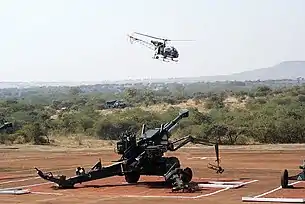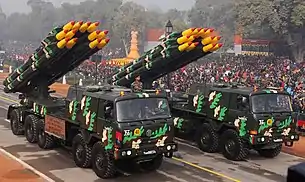Regiment of Artillery (India)
The Regiment of Artillery is an operational arm (a regiment/corps) of the Indian Army. Formerly part of Royal Indian Artillery (RIA) of British Indian Army which itself traces its origins to the formation of Bombay Artillery in 1827. It was later involved in extensive service in the First World War, in East Africa, Gallipoli, Mesopotamia and Palestine .
| Regiment of the Artillery | |
|---|---|
| Active | 1827–present |
| Country | |
| Allegiance | Republic of India |
| Branch | |
| Type | Artillery |
| Garrison/HQ | Nashik, Maharashtra |
| Motto(s) | Sarvatra Izzat-o-Iqbal (Everywhere with Honour and Glory) |
| Colors | While the guns are regarded as the regimental colours and are accorded the same compliments as the Standards, Guidons and Colours of the Cavalry and Infantry and the Banners of the Light Infantry and Services and Corps, the Artillery Regiments carry blue and burgundy red President's Banners. |
| Anniversaries | 28 September (Gunners' Day) |
| Decorations | Victoria Cross 1 Ashoka Chakra 1 Maha Vir Chakra 7 Vir Chakra 92 Yudh Seva Medal 3 Shaurya Chakra 56 Sena Medal(Gallantry) 441[1][2] |
| Insignia | |
| Regimental insignia | A gun with Star of India above it |
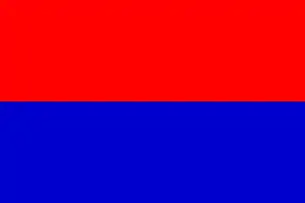
Today it is the second-largest arm of the Indian Army, and with its guns, mortars, rocket launchers, unmanned aerial vehicles, surveillance systems, missiles and artillery firepower it constitutes almost one-sixth of its total strength.
Its motto is Sarvatra Izzat-o-Iqbal (Everywhere with Honour and Glory), the Hindustani equivalent of the Royal Artillery motto Ubique Quo Fas Et Gloria Ducunt (Everywhere That Right And Glory Lead), and it shares the same symbol but with the Star of India in place of the Royal Crown. The Hindustani motto honors the memory of the Hindu and Muslim gunners who fought during the Indian Rebellion of 1857.
History
The Mughal Emperor Babur is popularly credited with introducing artillery to India, in the Battle of Panipat in 1526, where he decisively used gunpowder firearms and field artillery to defeat the much larger army of Ibrahim Lodhi, the ruler of the Delhi Sultanate, thus not just laying the foundation of the Mughal Empire but also setting a precedent for all future battles in the subcontinent. However, evidence of earlier use of guns by Bahmani kings in the battle of Adoni in 1368 and King Mohammed Shah of Gujarat in the fifteenth century have been recorded.
The East India Company raised the first regular company of artillery in 1748, with a small percentage of Indian gunners called Gun Lashkars, Tindals and Serangs. A few Indian mountain artillery batteries, officered by the British, were raised in the 19th century and formed part of the Royal Artillery.[3] The Royal Indian Artillery (RIA) of the British Indian Army was raised on 28 September 1827, as a part of the Bombay Army, a presidency army of the Bombay Presidency. It was later renamed as 5 Bombay Mountain Battery, and participated in the First Anglo-Afghan War (1839–1842).
The Indian Rebellion of 1857 sparked off in Meerut on 10 May 1857. Many of the Indian personnel of the Bengal Artillery were involved in the mutiny and the three battalions of foot artillery then in existence were all disbanded in 1862.[4] Subsequently, all Indian artillery units were disbanded except for four mountain artillery batteries of the Bombay Army[5] and four field batteries of the Hyderabad Contingent. Major Richard Keatinge of Bombay Artillery was awarded the Victoria Cross in 1858 for his service during the Indian Rebellion.

In the 20th century, the Artillery was later involved in extensive service in the First World War, in East Africa, Gallipoli, Mesopotamia, and Palestine.[3]
The Regiment of Artillery was raised on 15 January 1935, when the first three Indian Field Regiments, originally numbered A, B, and C were authorised.[6] Originally called the 'Indian Regiment of Artillery', which later became 'The Regiment of Indian Artillery' on 1 November 1940 and 'Royal Regiment of Indian Artillery' in October 1945, after its success in World War II.[5]
After the partition of India in 1947 the RIA was divided between the newly formed artillery regiments of India and Pakistan.[3] In the coming years, the Regiment of Artillery took part in all the operations fought by the Indian Army, the latest being the Kargil War.
The School of Artillery of the Indian Army is situated at Devlali near Nashik, and the Regiment of Artillery Museum, established in 1970, is also situated in Nashik at Nasik Road Camp.
The Regiment of Artillery was divided in the mid-1990s between the Field Artillery, the Corps of Air Defence Artillery formed in January 1994, and the Army Aviation Corps formed in November 1993.[7] The Field Artillery is the largest successor branch, with 190 regiments, but no longer accounted for a sixth of the army's 1.2 million 1996 strength.
Jane's Defence Weekly said in 1996 that divisional artillery deployed on India's plains is expected to have a mix of 130mm and 155mm guns.[8] This could be a combination of three 130mm regiments and one regiment of 155mm guns, or two regiments of each calibre, depending on the anticipated threat and whether the division is to be employed for offensive or defensive operations.
On 15 January 1985, a commemorative stamp depicting a gunner and howitzer from Mountain Battery was released by India Post, on the Golden Jubilee of the Regiment of Artillery[9]
During the 1999 Kargil War, the Indian artillery inflicted heavy damage to Pakistani infiltrators.[10] The role played by the artillery was praised by the top army brass, the divisional commander, a brigade commander and a battalion commander. Two of the officers in that conflict were then Gen. Ved Prakash Malik and then Lt. Gen. Sundararajan Padmanabhan both of whom went on to serve as the Chief of Army Staff.[11]
In 2009, 181 Light Battery took a pivotal step in its evolution when it was given the honour of converting to 1812 Rocket Regiment (equipped with the BM-30 Smerch) at Nasirabad. The regiment had the privilege of participating in the Republic Day parade, in New Delhi, on January 26, 2016.[12]
Regiment composition
According to army history in artillery, the regiments have been classified in the form of caste and culture. Some of the regiments have been divided into the caste system or some in the traditional culture or historical backgrounds. In regiments of artillery, the units have been allotted in the form of Sikhs, Jats, Dogras, Rajputs, Ahirs, Brahmins, Gurkhas, Marathas and SICs (South Indian Classes). There are also two airborne artillery units, 9 (Parachute) Field Regiment and 17 (Parachute) Field Regiment. Most of the artillery units have been affiliated to infantry units. On anniversaries of their raising days, the artillery units invited their affiliated units to join their celebrations.
Units and equipment
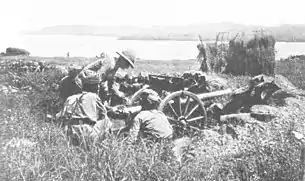
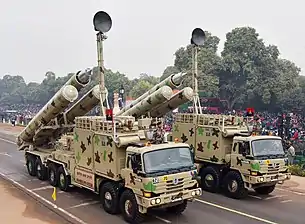
.jpeg.webp)
_passes_through_the_Rajpath%252C_on_the_occasion_of_the_69th_Republic_Day_Parade_2018%252C_in_New_Delhi_on_January_26%252C_2018.jpg.webp)
In the artillery, the regiments have been divided into different units. They have been classified into Airborne Regiments (9 and 17 Para Regiments) Medium Regiments, Light Regiments, Missile Regiments, Rocket Regiments (inc 1812 Regiment), Field Regiments, and SATA (Surveillance & Target Acquisition) Regiments and Batteries. SATA Batteries and SATA Regiments are the most important units in artillery as they are equipped with UAV Drones and ELM MAST Radar System.
There are three artillery divisions: 40 Artillery Division (Ambala, Haryana)(under Western Command); 41 Artillery Division (Pune, Maharashtra, under Southern Command); and 42 Artillery Division (Alwar, Rajasthan, under South Western Command). Individual regiments include 3 Medium Regiment;[13] 9 (Parachute) Field Regiment; 17 (Parachute) Field Regiment, both Parachute regiments dating to 1947; 34 Field Regiment, 36 Medium Regiment, 37 (Coorg) Field Regiment; 40 Field Regiment "Asal Uttar"; 861, 881,[14] and 1889 Regiments with the BrahMos surface-to-surface missile,[15] 1812 Rocket Regiment, and 1841 Light Regiment.
- Light Artillery(Mortars)
- 120 mm E1 Light Mortar
- Field Artillery
- 105mm 105 mm Indian Field GunLight Field Gun
- 122mm D-30 Howitzer
- Medium Artillery
- 130mm M-46 Field Gun; the upgraded version of this gun is the 155mm Sharang Artillery Gun
- 155mm Haubits FH77/B Howitzer
- 155mm Dhanush (howitzer)
- 155mm M777 howitzer
- 155mm DRDO Advanced Towed Artillery Gun System (ATAGS)
- Self-propelled Artillery
- 105mm FV433 Abbot self-propelled gun
- 130mm M-46 Catapult self-propelled gun
- 155mm K9 Vajra
- Rocket Artillery
- 122mm BM-21 Grad Multiple Barrel Rocket Launcher
- 214mm Pinaka Multi Barrel Rocket Launcher
- 300mm BM-30 Smerch Multiple Barrel Rocket Launcher - 1812 Rocket Regiment equipped in 2009
- Missile Artillery
- Brahmos Missile System (861 - 864 Missile Regiments)
- Agni Missile System
- Prithvi Missile System
- Prahaar missile
- shaurya missile
- S-400 missile system
- Surveillance & Target Acquisition
Notable personnel
- Chief of Army Staff of the Indian Army
- General Paramasiva Prabhakar Kumaramangalam (7 June 1966 – 7 June 1969)
- General Om Prakash Malhotra (31 May 1978 – 31 May 1981)
- General Sunith Francis Rodrigues (30 June 1990 – 30 June 1993)
- General Sundararajan Padmanabhan (30 September 2000 – 31 December 2002)
- General Deepak Kapoor (30 September 2007 – 31 March 2010)
- Captain Umrao Singh Yadav : Victoria Cross:World War II.
See also
- List of regiments of the Indian Army#Artillery - full list of regiments
Further reading
- History of the Regiment of Artillery, Indian Army, by Y. B. Gulati, D. K. Palit. Published by Leo Cooper, 1972. ISBN 0-85052-118-1.
- Kargil '99: Blood, Guts and Firepower, by Gurmeet Kanwal, India Army. Regiment of Artillery. Published by Regiment of Artillery in association with Lancer Publishers, 2000. ISBN 1-897829-64-7.
References
- Indian Army website.
- SP's Land Forces : Guns and Glory - A Saga of Dedication and Valour website.
- History of Artillery, Indian Army.
- W.Y. Carmen, page 12 "Indian Army Uniforms under the British. Artillery, Engineers and Infantry", Morgan-Grampian: London 1969
- Regiment of Artillery Global Security
- Indian Field Artillery in World War II
- Sawhney, Jane's Defence Weekly, 9 October 1996, p.35
- Pravin Sawhney, 'India's artillery a force in its own right,' Jane's Defence Weekly, 9 October 1996, p.35-37
- 15th Jan 1985 StampIndia Post. Archived 17 April 2007 at the Wayback Machine
- "Indian artillery inflicted maximum damage to Pak during Kargil". Zee News. Retrieved 26 November 2014.
- "Battle-Winning Role of the Gunners in Kargil War". Indian Defence Review. Retrieved 4 April 2016.
- "Hindustan Times Article – Republic Day 2016". Retrieved 9 September 2020.
- 3 Staggered Clashes Took Place in Galwan Valley
- "'69th R-Day Marked With a Grand Parade and ASEAN Leaders as Guest' in The Quint". 26 January 2018. Retrieved 22 October 2020.
- "Brahmos test fired off the coast of Orissa". Indian Defence. Archived from the original on 31 July 2012. Retrieved 6 September 2012.
External links
| Wikimedia Commons has media related to Artillery of India. |
- Regiment of Artillery at Official website of the Indian Army
- Martyrs of Regiment of Artillery Indian Army
- Regiment of Artillery at Bharat Rakshak
- WeGunners
- 4 Hazara Mountain Battery (FF)
